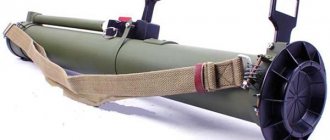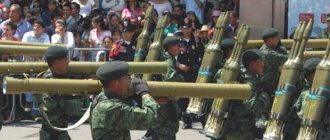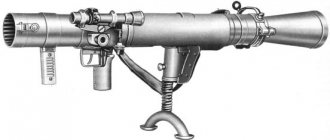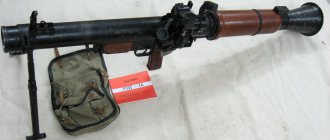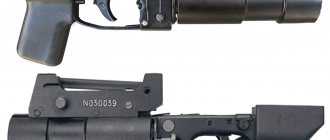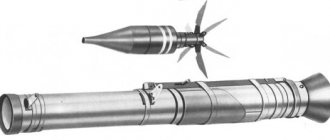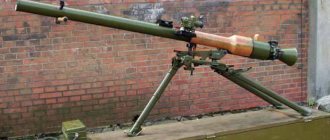The RPG-7 is a truly unique and legendary weapon, not much inferior in popularity to the famous AK-47. RPG-7 is an anti-tank grenade launcher, an effective means of combating tanks and other armored vehicles. It allows the infantryman not to feel defenseless in the face of an armored mechanical monster.
The RPG-7 was adopted by the Soviet Army back in 1961, and despite its advanced age, it still remains in service. This grenade launcher has participated in countless conflicts and wars on all continents. And the emergence of new, more advanced ammunition makes the RPG-7 dangerous even for modern tanks and armored vehicles.
RPG-7 is the favorite weapon of partisans and revolutionaries. It was used by Viet Cong fighters in the Vietnamese jungle and by the Afghan Mujahideen against Soviet troops. A photograph of a rebel or partisan with an RPG pipe on his shoulder is almost as natural as with a Kalashnikov assault rifle in his hands. In its simplicity, cheapness and effectiveness, this weapon is in no way inferior to the Kalashnikov assault rifle.
No one knows how many copies of the RPG-7 are fighting in different countries around the world today. Experts believe that only “legal” (that is, released by the manufacturer or under his license) copies were produced more than a million units. No one can say how many grenade launchers were produced without a license or were stolen from military warehouses after the collapse of the USSR.
History of creation
The entire history of weapons development is a race of models designed to counteract each other. The infantry problems that appeared during the First World War, new combat vehicles, such as tanks, armored vehicles of various designs, and aircraft, required a reliable means of combat.
With the development of armored vehicles, the means of combating them also changed, but there was no truly effective means of destroying them. Various anti-tank rifle systems had too small a caliber or low armor penetration.
Anti-tank hand grenades were seriously limited in their throwing range; Molotov cocktails, also limited in their range, were, in fact, more dangerous for the infantryman himself. Artillery, for all its advantages, did not have the maneuverability of infantry. Therefore, designers were looking for another way to create means of combating technology.
The pioneers in this area were the Americans and the Germans, who created, respectively, the Bazooka and the whole family of Faustpatron, Panzerfaust, and Panzerschreck during the Second World War.
The Soviet army appreciated these guns, and the question arose about creating something similar. Using the rich experience of the past war, as well as the developments of previous versions and designs, the GSKB-47 weapons bureau began to create a new model in 1958.
Work progressed relatively quickly, and already in 1960 the first prototypes were tested at the test site.
It is noteworthy that the group from Kovrov working on the new weapon was led by the son of the famous gunsmith Degtyarev, creator of many weapons products, Vladimir Vasilyevich Degtyarev.
In 1961, the model was put into service under the name RPG-7 hand-held anti-tank grenade launcher. GRAU gave the new weapon the index “6G3”. The history of the anti-tank grenade launcher, known and loved throughout the world, began.
Briefly about the main advantages and disadvantages of the RPG-7
The main advantages of the RPG-7, which have been appreciated around the world, are:
- Weapon reliability;
- Minimum price;
- No recoil when firing;
- Ease of use.
In addition to these undeniable advantages, the RPG-7 has one serious drawback. The launch of a rocket is accompanied by a jet stream of the starting charge, which can cause damage at a distance of up to 30 meters. To avoid the consequences of this deficiency, you must strictly follow safety precautions.
Since the Soviet Union actively supplied the RPG-7 as military aid to a large number of countries supporting the path of socialism, this grenade launcher is now in service in more than 40 countries around the world.
Grenade launcher design
The new weapon is a logical continuation of its predecessor, the RPG-2, which attracted military personnel and engineers with its design.
It was distinguished by dynamo-reactivity, which means it had no recoil when firing a shot.
Reusable design with a relatively small number of components. The ammunition for the product is over-caliber.
Trunk
Consists of two parts connected by thread. The pipe and pipe are necessary to determine the flight line of the ammunition, as well as the removal of powder gases generated during firing. There is a grenade holder cutout in front.
On the right side of the body there are swivels for belts, a case and a shoulder strap. To protect the grenade launcher from burns there are 2 pads, usually made of birch veneer. There was an important improvement compared to the 2nd model of this line.
In the middle part of the 7th, an extension of the barrel was made, a “nozzle”, which is 2 cones, for the most useful energy consumption of the expelling charge.
The breech, made with a bell, has undergone changes to make the product recoilless. This part has a safety plate that serves as protection against soil contamination when moving on the battlefield, marching or in bivouacs.
Trigger
With trigger and push-button safety. The hook is not protected by a safety guard, so the safety is more important than ever.
In order to set the fuse, you need to press the button to the right.
The transfer to the combat position is carried out using a knitting needle, which is brought into readiness with the thumb of the right hand.
Aiming
Can be produced in several ways. Starting from the earliest models, the RPG-7 had a PGO-7 optical sight, which was modified several times.
The basic model was designed for shooting up to half a kilometer, and included the following components:
- The scale of the sight is horizontal lines, the division value is one hundred meters
- Lateral correction scale, vertical line, from 0 to 10 (thousandths)
- The rangefinder scale, a curved dotted line and a solid horizontal line, is designed for 2.7 meters, which is exactly the height of the average tank.
Scales marked with numbers should be multiplied by 100 during calculations, for example, the number “3” means 300 meters. The lateral correction division numbers are located below, from 1 to 5.
In itself, PGO-7 is a fairly complex optical device, designed for use in harsh conditions. Thus, it can withstand temperature fluctuations from -50 to +50 degrees Celsius, and nitrogen in the metal case prevents fogging. For the convenience of the grenade launcher, the sight has light filters, which allows it to be used in difficult weather conditions. The rubber cap is designed to combat solar glare, an eternal problem with optics in war.
For shooting at dusk or at night, a backlight is installed, powered by galvanic elements.
Modifications of the main sight are varied:
- Night sight, or special PGN-1, as well as universal NSPUM, or representative of the second generation NSPU-3;
- A universal sighting device developed and introduced in 2001 on modified RPG-7V2. Essentially, a mechanical addition to the basic optics weighing 550 grams, allowing for improved aiming while increasing the firing range of new types of shots;
- A huge number of homemade products, both completely official, tested in countries that are armed with a grenade launcher, to samples made “on the knees” to replace standard sights that broke for various reasons. It can vary from laser and collimator devices to optics taped with electrical tape from a hunting rifle;
- A mechanical sight is used in case the standard one is damaged and it is impossible to replace it in a timely manner.
Design features of RPG-7
A special feature of the grenade launcher is that the grenade, flying out of the RPG-7 barrel, gives virtually no recoil. This type of weapon is called dynamo-reactive. When developing the RPG-7, multiple use recoilless launch schemes were used, which showed excellent results in the tests of the RPG-4. The RPG-7 grenade launcher itself consists of the following parts:
- A barrel on which two types of sights are placed, mechanical and optical;
- Striker mechanism;
- Trigger system, which is equipped with a safety lock.
The RPG-7 barrel itself consists of a branch pipe and a pipe. Its purpose is to direct the flight of the charge and remove the powder gases that are released when fired. The RPG-7 grenade launcher has a barrel widened in the middle, which allows for more efficient use of the charge energy, thereby increasing its flight range. The bell, which is located in the breech of the barrel, provides the weapon with recoillessness.
Specifications
The characteristics of the RPG-7 can be divided into general and combat.
- 40 mm caliber weapon
- Weighs 6 kg. 300 g, while the grenade weighs from 2 to 4.5 kg.
- 950 mm product length
Combat tactical and technical characteristics, data for the most successful samples of shots of various modifications:
- Up to 330 m firing range when using a PG-7V grenade
- 700 m. sighting range for OG-7V
- 750 mm of tank steel is penetrated by a PG-7VR grenade
- From 112 to 145 m/s initial velocity of fired ammunition
It is worth noting that combat characteristics vary greatly due to the large number of weapon modifications and different types of shots. Thus, grenade launchers and grenades from the 1960s and 1970s are much inferior to modern developments. Although they continue to remain a formidable weapon in capable hands.
RPG-7 grenade launcher. Firing range. Weight. Dimensions. Caliber
The RPG-7 grenade launcher (GRAU index - 6G3) is a Soviet / Russian reusable hand-held anti-tank grenade launcher (also a rocket-propelled anti-tank grenade) for firing cumulative ammunition. Designed to combat tanks, self-propelled artillery units and other enemy armored vehicles, it can be used to destroy enemy personnel in shelters, as well as to combat low-flying air targets.
Grenades for RGD-7
The developed product had a wide range of applications. Therefore, a large number of grenades were developed for the most effective use. It itself is divided into 3 parts. The first, the head one, hits the target.
By the way, the developers incorporated an interesting mechanism: if for some reason the grenade did not go off, due to a miss, or due to technical problems, the self-destruct mechanism was triggered and the warhead exploded. The second part is a jet engine that accelerates the charge and ensures flight along the trajectory specified by the shooter. The third part is a powder expelling charge, thanks to which the device leaves the grenade launcher tube.
The shots had different purposes, cumulative, thermobaric and others, to combat both enemy equipment and manpower. The most interesting are the developments created directly during combat operations.
This was facilitated by both the technical capabilities of the grenade and its position outside the barrel, which does not limit the possibility of additional “body kit”.
So, Chechen militants poured gasoline into a grenade and hung it with sabers. The tactical and technical characteristics of the shot dropped significantly; it was pointless to shoot such a miracle grenade at a distance of more than 70 meters, but in urban combat it showed itself quite well, rather causing a demoralizing effect on Russian soldiers.
Let's look at the main shots fired for the RPG-7:
- PG-7V/7P1, commissioned in 1961, cumulative type, with armor penetration 260 mm;
- PG-7VM / 7P6, developed in 1969, also cumulative, increasing penetration to 300 mm;
- PG-7VS / 7P13, model 1972, cumulative, with armor penetration 400 mm;
- PG-7VL "Luch" / 7P16, commissioned in 1977, increasing the performance to 500 mm, but reducing the sighting range from 500 (for previous models) to 300 meters;
- PG-7VR “Resume” / 7P28, 1988, tandem ammunition capable of penetrating dynamic protection and 650 mm armor, at a range of 200 meters;
- TBG-7V "Tanin" / 7P33, 1988, for combating manpower, the first thermobaric shot for this type of weapon. This type of ammunition is comparable in quality to a 120-mm artillery shell or a mortar mine of a similar caliber;
- OG-7V “Oskolok” / 7P50, 1999, when exploded, it strikes all living things in an area of 150 sq.m., with a target range of 300 m.
The history of the RPG-7
After the end of the Great Patriotic War, by the beginning of the 1950s, the main anti-tank weapons of the USSR army were:
- Guns B-10 and B-11;
- RPG-2 hand grenade launcher;
- Rifle grenade launcher VG-45;
- SG-82 easel grenade launcher;
- RKG-3 grenade.
By 1954, having conducted large-scale research on the compliance of the weapons of the USSR army with modern realities, NII-3 of the artillery department issued an order to develop more modern models of hand grenade launchers.
At this time, many defense enterprises throughout the USSR were developing grenade launchers. Since the development of grenade launchers was not a priority, initial developments were often transferred from one design bureau to another. In order to quickly develop a new grenade launcher, GSKB-47 was appointed responsible for the development of new weapons, and all documents and developments were transferred there.
During these years, GSKB-47 created its own development of a grenade launcher, which, after a series of tests, was named RPG-4. This device significantly surpassed the RPG-2 in its characteristics. In 1961, the first tests of the RPG-7 with a rocket shot were carried out, in which this weapon showed such performance characteristics that the RPG-4 grenade launcher was never adopted for service, as the least promising model.
The first grenade launcher, which was developed by GSKB-47 (now this enterprise is called SNPP "Basalt"), and was put into service, was the RPG-7 grenade launcher. The charge for this grenade launcher was named PG-7V. The chief designer of the RPG-7 grenade launcher was Firulin, who also developed a cartridge for this grenade launcher, receiving a state prize for this in 1964.
The RPG-7 grenade launcher, adopted for service on June 16, 1961, is still in service with the Russian army. Various sighting devices for the RPG-7 made this weapon multifunctional.
Grenade launcher modifications
Over its relatively long history, the RPG-7 device has undergone several upgrades, mostly related to sighting devices. The simple device of 7, in principle, did not need serious modernization.
Meanwhile, at one time the army received:
- RPG-7V, changes affected the sight, it was coordinated to correct some shortcomings;
- RPG-7D, version for paratroopers, with the ability to disassemble and supplemented with a bipod;
- RPG-7N / RPG-7DN, the first modifications equipped with night sights;
- RPG-7V1, changes again befell the sighting device, due to the adoption of a new type of shots and new requirements for firing them;
- RPG-7D1, the landing model received a new sight PGO-7V3;
- RPG-7V2, RPG-7D2 - in 2001, both versions of the grenade launcher received the latest sighting device, which was described above;
- RPG-7D3, a copy of RPG-7V2 for airborne troops;
- Airtronic USA RPG-7, Airtronic USA Mk.777, exact copies of the Soviet RPG, produced in the USA for domestic use and, according to some information, for various armies of the world. The last option is a lightweight version that is not designed for long-term use.
Ways of development and modernization of RPG-7
Grenade launcher with RPG-7. A mechanical sight and a PG-7VL shot are used. Photo by the Russian Ministry of Defense
In 1961, the RPG-7 anti-tank rocket launcher with a PG-7V cumulative round entered service with the Soviet Army. Subsequently, this system began to be developed and improved, thanks to which it still meets the basic requirements of the armies and retains its place in the troops. Such a long service was facilitated by the high modernization potential of the design - by modifying or replacing individual elements, new capabilities could be obtained.
Starting device
The main element of the RPG-7 anti-tank system is the grenade launcher itself - a recoilless launcher with guidance and fire control means. This product was initially distinguished by its highly perfect design and actually did not need any modifications. However, later it was redesigned several times for one purpose or another.
Landing RPG-7D. Photo: Wikimedia Commons
In 1963, the RPG-7D modification grenade launcher entered service with the Airborne Forces. Its differences were in the detachable design of the pipe-barrel and the presence of a bipod. Otherwise it was identical to the basic RPG-7. Subsequently, modification “D” was improved, but without changing the design of the starting device.
Curious options for modernizing the RPG-7 have appeared abroad in recent decades. For example, the American company Airtronic has been producing the RPG-7 grenade launcher since 2009, a copy of a Soviet product with modified ergonomics. Plastic is widely used in the design; standard rails for additional devices are installed on the barrel. The shape of the handles has changed, and an adjustable stock has also appeared.
One of the grenade launchers from Airtronic USA. Photo Airtronic-usa.com
Later they introduced the Mk 777 grenade launcher, a lightweight version of the RPG-7. He received a composite barrel with a steel liner and a fiberglass pipe. The composition of attachments has been reduced. Due to these measures, the grenade launcher's own weight was reduced to 3.5 kg. Other options for improving the starting device were also proposed.
Ammunition nomenclature
The main objective of the development of the basic RPG-7 was to increase combat characteristics, which resulted in the appearance of new shots. In the early years, the main direction of improving ammunition was to reduce size and weight while simultaneously increasing armor penetration. Subsequently, fundamentally new combat units appeared. It is curious that in all cases a unified set of elements is used - starting charge, engine and tail.
Night shooting with day sight. Photo by the Russian Ministry of Defense
85-mm over-caliber grenade PG-7V mod. 1961, with a mass of 2.2 kg, penetrated 260 mm of armor. At the end of the sixties, the PG-7VM product with an improved shaped charge was created. With a mass of 2 kg and a caliber of 70 mm, it already penetrated 300 mm. The next representative of the family, PG-7VS, penetrated 400 mm at the cost of a slight increase in caliber. At the end of the seventies, the PG-7VL "Luch" shot with an enlarged 93-mm warhead was adopted - it penetrated 500 mm of armor.
The development of means of protecting armored vehicles led to the appearance of the PG-7VR round with a tandem warhead. The grenade has an increased length and weighs 4.6 kg and carries a 64-mm leading charge and a 105-mm main charge. When the lead charge hits the target, it triggers the dynamic protection, after which the main charge penetrates up to 650 mm of armor. However, the increase in power was accompanied by a reduction in the target range.
PG-7VL shots. Photo by the Russian Ministry of Defense
Also in the late eighties, a grenade was developed to destroy manpower, unprotected equipment and buildings - TBG-7V. It was equipped with a thermobaric warhead with a damage radius of 8-10 m. A few years later, the OG-7V shot with a fragmentation warhead containing 400 g of explosive appeared.
Foreign countries also tried to develop their own shots for the RPG-7. Thus, the already mentioned company Airtronic produces the SR-H1 cumulative grenade. The product, with a caliber of 93 mm and a mass of 3.82 kg, penetrates 500 mm of armor. Practical ammunition for grenade launcher training is also offered.
Inert shot from Airtronic. Photo Airtronic-usa.com
Sights
Another direction of development of the RPG-7 was the consistent development of new sighting devices.
First of all, it was associated with the advent of improved ammunition with changed ballistics. However, some sights were created to provide new combat capabilities. In the first modification, the RPG-7 was equipped with an integrated mechanical sight, serving as an auxiliary sight, and an optical PGO-7. The latter was a sight with a 2.7x magnification with markings for determining the range to the target and firing.
Shots for the grenade launcher: tandem cumulative PG-7VR, fragmentation OG-7V and thermobaric TBG-7V (at the edge of the frame). Photo Vitalykuzmin.net
Already in the early sixties, the PGO-7V sight was created - an improved version of an existing product. It introduced some innovations that were retained in all subsequent modifications. This design received further development only in the late eighties in connection with the advent of new “heavy” rounds PG-7VR and TBG-7V. The PGO-7V3 sight with the corresponding aiming scale was intended for them.
In the early seventies, it was possible to use a grenade launcher at night. The RPG-7N/DN product was equipped with PGN-1 and NSPU(M) sights. They made it possible to fire at tanks from ranges up to 500-600 m. The sight scales were designed for the few existing shots.
RPG-7VR grenade launcher with PGO-7V3 sight. Photo Vitalykuzmin.net
At the turn of the nineties and two thousand, with the advent of new models of grenades, the so-called. universal sighting device UP-7V. With its help, the RPG-7 could effectively use fragmentation and thermobaric rounds at extended ranges. For TBG-7V, the firing range increased from 200 to 550 m, for OG-7V - from 350 to 700 m.
Foreign countries have repeatedly made attempts to independently improve RPG-7 sighting devices. For example, in 2022, the Belarusian Center for Scientific Research and Design presented the Ovod-R grenade launcher. It was a standard grenade launcher with a PD-7 “smart” sight. The latter is an optical-electronic system with a day channel and a laser rangefinder (the night channel is provided by a separate attachment), as well as a set of weather sensors and a ballistic computer. It was claimed that the PD-7 is capable of accurately calculating targeting data and provides more effective fire with all compatible rounds.
Landing RPG-D3 with UP-7V sight. Photo Vitalykuzmin.net
Room for upgrades
It is easy to see that the RPG-7 anti-tank rocket launcher and its ammunition in the first versions were not very complex in design.
At the same time, they had fairly high firepower and made it possible to effectively fight armored vehicles and thereby increase the combat effectiveness of the infantry. However, the development of armored fighting vehicles gradually reduced the value of grenade launchers. The relative simplicity of the design of the grenade launcher and its grenades made it possible to carry out modernization without any particular difficulties, obtaining various remarkable results. Serious reworking of the launcher did not make sense - in our country only a collapsible airborne grenade launcher was created. The development of ammunition and sighting devices was much more active, and these two areas were directly related to each other.
Belarusian "Gadfly-R" with a PD-7 sight. Photo Naviny.by
By combining different versions of the launcher and sights, Soviet and Russian designers created a dozen modifications of the basic RPG-7 with various features. Later versions of the grenade launcher are compatible with a full list of domestic shots - and have broad combat capabilities. The process of improving weapons and grenades is also ongoing abroad, which adds to the general list of products.
Simplicity, low cost, efficiency, as well as the possibility of quick and easy modernization with an increase in basic characteristics have helped the RPG-7 grenade launcher of all major modifications become widespread throughout the world. This weapon has been in use for almost 60 years and is unlikely to go away anytime soon. One of the reasons for this may be new modernization projects - using the groundwork and renewal techniques formed and tested in the past.
Combat use
From its creation to this day, and in the near future, the RPG-7 grenade launcher has been a participant in almost all wars and conflicts on planet Earth. Just like the Kalashnikov assault rifle, this type of weapon has found hundreds of thousands of loyal supporters and fans around the world.
The beginning of the 7's combat career began in Vietnam, where the USSR supplied it along with other types of weapons. The North Vietnamese partisans appreciated the Soviet creation, but for the Americans it became another headache. Gasoline engines of United States equipment, by the way, fit perfectly into the general concept of using new weapons.
The tank crew's losses immediately increased significantly. 128 rotorcraft of various classes were destroyed by grenade launcher fire, which exceeded the same figure for MANPADS. The second major war of the 7 was Judgment Day in the Middle East.
Despite Israel's victory, the IDF tank crews suffered greatly from the Arab grenade launchers.
The RPG-7 became widespread in wars on the African continent. Reliability, simplicity and low cost, together with great power, made this weapon extremely popular among participants in all conflicts, often on both sides.
The technique of combating RPGs with low-flying aircraft was also widely used there.
Thus, during the war in Angola, a group of Cuban special forces shot down an SA.330 Puma. In Mozambique, the C-47 Dakota and even the C-130 Hercules were killed by 7 fire.
In the battle for Mogadishu in Somalia, rebels shot down then modern (this was in 1993) UH-60 Black Hawk helicopters and a pair of MH-60Ls. With the introduction of troops into Afghanistan, Soviet soldiers were attacked by their own weapons.
Soviet grenade launchers successfully used the excellent characteristics of their grenade launchers in battles with the Mujahideen, but the latter also successfully used the same models against armored vehicles.
It was there that the tactic of destroying convoys became widespread, when several militants with grenade launchers knocked out the first and last car of the convoy, and then fired at the cars stopped on the road. Thanks to the differences in altitude, counter-helicopter warfare with the help of an anti-tank grenade launcher received a new birth.
In 1984, the Mujahideen managed to seriously damage the Mi-24 Krokodil attack aircraft, which resulted in an unsuccessful landing and subsequent crash.
The year 1985 was marked by the mass death of Afghan Komsomol workers who were shot down while flying on an Mi-6. As in the previous case, the accident was caused by a grenade hit from an RPG-7.
The first war in Chechnya was replete with examples of the successful use of this type of weapon against Russian soldiers. Thus, the New Year's assault on Grozny in 1994-1995 turned into a real tragedy for the storming units, largely due to the abundance of grenade launchers among the militants of Ichkeria.
For example, the Northern group, which included the notorious Maykop brigade, lost 48 tanks, about 159 infantry fighting vehicles, and 7 Tunguska self-propelled anti-aircraft guns during the assault. The tactics of the militants defending Grozny were relatively simple, and were built precisely around the type of weapon in question. A shooter with an RPG fired, and he was covered by a couple of machine gunners.
After the tank was damaged, the militants’ machine gunner did not allow the vehicle and crew to be removed, and the sniper eliminated the manpower. It is worth saying that on average, militants spent 8-10 accurate shots to destroy one T-80, since these vehicles have reactive armor.
Thus, in this conflict, much was decided by the quantity of ammunition.
The practice of shooting at helicopters continued.
This weapon became widespread in the conflicts in Iraq and Afghanistan after the invasion of American troops there. Since in these regions the warehouses mainly contained obsolete types of ammunition for the 7th, it is somewhat inappropriate to talk about the effectiveness of combating armored vehicles.
Despite the factor of outdated grenades, during the battles several pieces of heavy equipment were destroyed by the fire of this particular grenade launcher. It goes without saying that the experience of firing at air targets was successfully applied in battles in this theater of operations.
According to rough estimates, about 3 million RPG-7s were produced, spreading throughout the world. It is successfully used throughout the globe where there is war. Therefore, it is too early to put an end to the history of this successful example of a hand grenade launcher.
Interesting Facts
- The projectile will always fly below the reticle.
- Along with the Gauss gun and knife, the RPG-7u is the most powerful weapon in the game, although the impressive weight of the grenade launcher (7 kg) and charges (2 kg for one rocket) does not allow it to be used often.
- RPG-7u has external differences in the charged and uncharged state.
- The RPG-7u kills the controller and the chimera with the first shot, and the pseudo-giant - with an accurate hit from two.
- If you throw an RPG-7u next to some stalker, he will pick it up, and when enemies appear, he will shoot until he kills the enemy or himself.
- Grenades can only be obtained from caches or from the grenade launchers themselves. There are only 8 of them: 6 in caches (1 cache each in the Swamp, in the Landfill, in Agroprom and its dungeon, in Yantar and in the Red Forest) and 2 in grenade launchers.
- If you shoot vertically upward, the charge will turn around at the height and fall to the ground in the same place.
- Interestingly, the game uses a crosshair alignment mark as an aiming mark.
- NPCs notice the GG when an RPG is fired at them at any distance.
- You can sell an empty grenade launcher to the stalkers, get a weapon in front of him, and he will point the RPG at you. Then, having killed him, we will find the grenade launcher loaded.
- In the first versions, the grenade launcher taken from the Hermit fires without wasting ammunition. To do this, you need to break it 100%, discharge it through your inventory, and shoot with an empty RPG. The shot will be without recoil or sound, and the message “The weapon is jammed” will appear on the screen. Needs recharging."
PG-18 grenade
The grenade has a caliber warhead and a jet engine. The jet engine contains a reactive charge consisting of PPK-5 gunpowder. The explosive okfol is used as an explosive projectile, which is a chemical compound that causes detonation under certain conditions.
Okfol is located in the main part of the grenade and weighs 312 grams.
A jet engine is threaded to the rear of the grenade body. In the engine chamber there is a charge with pyroxylin powder in the form of tubes. The chamber ends with a nozzle block with a stabilizer of four blades and a boost unit. In the transition bottom there are inclined holes through which flowing powder gases pass. They impart rotation to the grenade at approximately 10 revolutions per second. At the time of departure, the grenade reaches a speed of 114 m/s.
The grenade flies like a ballistic body, which is why it is practically insensitive to side winds.

